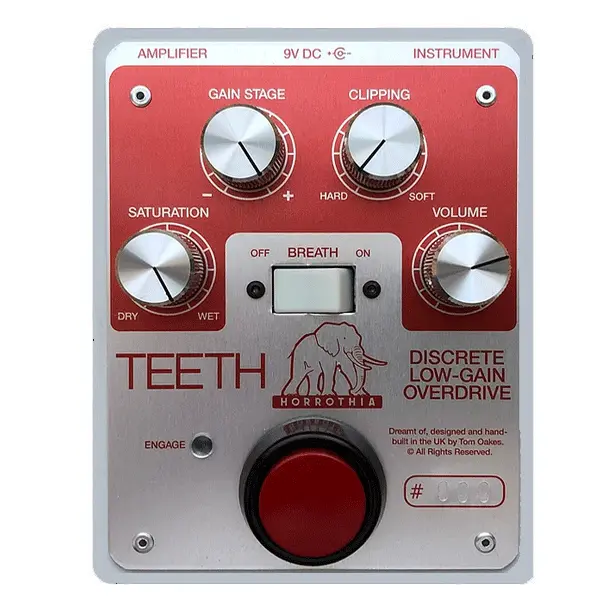
From the descriptions of its pedals, UK’s Horrothia FX clearly devises its creations as tools for solving very specific sonic problems, coming from a distinct recording engineering angle.
The company’s discrete low-gain overdrive Teeth, a 9 transistor design, all analog design, using no IC opamps, was imagined as a necessary device to solve the following problem:
Clean was always dull, especially at volumes correct for small stages, or late night recordings. Overdrives added too much crunch, even at the lowest settings. Teeth is the solution to the conundrum. It is a low gain overdrive with a blend between completely clean and slight grit.
The two signals – the clean one and the “edge of break-up overdriven one – are blended through the Saturation knob, which gets close to 100% all the way up and completely clean at zero. That same knob also raises the overall gain, while the amount of distortion of the wet channel is set through the Gain Stage knob.
The Clipping control affects the quality of the clipping, delivering “from a soft squashy compression to a more squared-off, harder, traditional low gain drive.”
A big on/off-style white switch in the center of the pedal, named Breath, brightens the clean signal in the mid-highs for a slightly more piercing tone.
Here’s the video of the Horrothia FX TEETH Discrete Low-Gain Overdrive.
Glassy cleans and edge of breakup infinitely combined
Teeth was a necessary evolution. Clean was always dull, especially at volumes correct for small stages, or late night recordings. Overdrives added too much crunch, even at the lowest settings. Teeth is the solution to the conundrum. It is a low gain overdrive with a blend between completely clean and slight grit.
Teeth has two sides, a very transparent dry side and an ‘edge of breakup’ wet side. These are mixed by the Saturation knob, with full left being clean, and full right being almost only overdrive with a hint of clean. Saturation is also a gain control; as you move to the right, it increases the gain at the same time as changing the blend. The maximum gain is get by the Gain Stage knob, giving you limitless combinations of clean and drive.
The Clipping control changes the shape of the overdrive clipping, from a soft squashy compression to a more squared-off, harder, traditional low gain drive.
The Breath switch adds an airiness to the upper mid frequencies on the boost side giving out-of-phase pickup selections some chance to breathe and cut through the mix / bar / bedroom / studio.
Teeth is a 9 transistor design, all analogue design, using no IC opamps. No modelling, nothing digital. There are two completely discrete transistor based opamps inside (using hand selected components) for supreme tonal clarity.






















